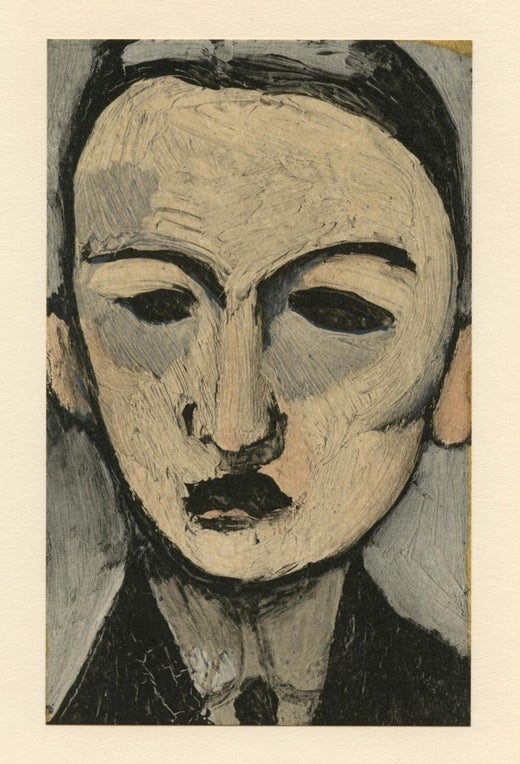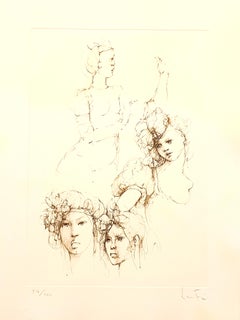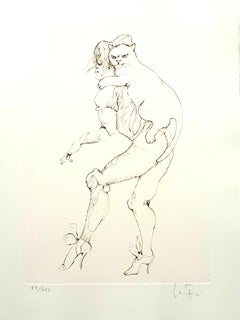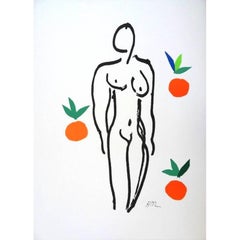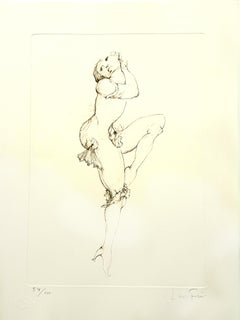Want more images or videos?
Request additional images or videos from the seller
1 of 7
(after) Henri Matisseafter Henri Matisse - Resting Blue Nude1952
1952
Price:$1,555.58
About the Item
- Creator:(after) Henri Matisse (French)
- Creation Year:1952
- Dimensions:Height: 29.93 in (76 cm)Width: 22.05 in (56 cm)Depth: 0.04 in (1 mm)
- Medium:
- Movement & Style:
- Period:
- Condition:
- Gallery Location:Collonge Bellerive, Geneve, CH
- Reference Number:1stDibs: LU16122460083
(after) Henri Matisse
Henri Matisse was born on December 31, 1869, in Le Cateau-Cambrésis, France. At 22, he had given up studying law in Paris to pursue painting. He had briefly studied art at the Académie Julian and Ecole des Beaux-Arts with Gustave Moreau. At 32, Matisse exhibited at the Salon des Indépendants in Paris, where he met Maurice de Vlaminck, who with Matisse would eventually lead the Fauve art movement. Matisse's work was included in the 1913 Armory Show in New York, and throughout the 1910s and into the 1920s, his work began to find collectors around the world. Throughout the 1920s and 1930s, he divided his time between Paris and southern France, producing paintings, sculpture, lithographs, and etchings. Like many avant-garde artists in Paris, Matisse was receptive to a broad range of influences, particularly 'primitive' art, Near Eastern decorative art, African masks and sculpture, impressionist color, cubism, and the paintings of Paul Cezanne. The artist's images of the human face and figure -rendered in fluid lines and flat fields of color- typify these influences. Matisse argued for the prominence of instinct in art production, believing that an artist should not have complete control over color and form. He died on November 3, 1954, in Nice.
About the Seller
4.9
Platinum Seller
Premium sellers with a 4.7+ rating and 24-hour response times
Established in 2015
1stDibs seller since 2015
965 sales on 1stDibs
Typical response time: 1 hour
Authenticity Guarantee
In the unlikely event there’s an issue with an item’s authenticity, contact us within 1 year for a full refund. DetailsMoney-Back Guarantee
If your item is not as described, is damaged in transit, or does not arrive, contact us within 7 days for a full refund. Details24-Hour Cancellation
You have a 24-hour grace period in which to reconsider your purchase, with no questions asked.Vetted Professional Sellers
Our world-class sellers must adhere to strict standards for service and quality, maintaining the integrity of our listings.Price-Match Guarantee
If you find that a seller listed the same item for a lower price elsewhere, we’ll match it.Trusted Global Delivery
Our best-in-class carrier network provides specialized shipping options worldwide, including custom delivery.You May Also Like
Nude Sculpture R.B. Kitaj drawing of nude woman on handmade orange paper print
By Ronald Brooks Kitaj
Located in New York, NY
Here Kitaj depicts a sculpture of a nude woman, shaded delicately in black, printed on wonderfully textured handmade muted orange paper. The woman’s hand reaches to the inside of her...
Category
Late 20th Century Modern Nude Prints
Materials
Lithograph
Le peintre et son modèle
By Pablo Picasso
Located in Wien, 9
- dated in the plate 11.1.64
- original lithograph as frontispiece of the monograph Picasso. Lithograph
- edition 3000
- unsigned
- cat. raisonné Mourlot 1970; cat. raisonné Bloch 1155
Category
1960s Modern Figurative Prints
Materials
Lithograph
Three seated figures
By Henry Moore
Located in London, GB
Colour lithograph on paper.
Hand-signed and numbered by the artist.
Paper size: 33 x 28 cm
H.C. aside from an edition of 50
Henry Moore's (1898-1986) drawings and prints offer a un...
Category
1980s Modern Figurative Prints
Materials
Lithograph
The Lord and the Dame [Le Seigneur et la dame]
By Pablo Picasso
Located in London, GB
Medium: Original Lithograph, Cannes, 10/1/1959, on Arches paper, dated lower left
32.8 x 26 cm - sheet
Edition: This was an unsigned and unnumbered edition of 800
Printed by: Mourl...
Category
1970s Modern Figurative Prints
Materials
Lithograph
Two blocks from Twenty-Five Nudes by Eric Gill, 1938
By Eric Gill
Located in Middletown, NY
London: J. M. Dent & Sons, 1938.
Each a woodblock print on white wove paper, 8 11/16 x 5 1/2 inches (219 x 139 mm), the full sheet. Each image in excellent condition, printed on one...
Category
Mid-20th Century Modern Nude Prints
Materials
Lithograph
Two blocks from Twenty-Five Nudes by Eric Gill, 1938
By Eric Gill
Located in Middletown, NY
London: J. M. Dent & Sons, 1938.
Each a woodblock print on white wove paper, 8 11/16 x 5 1/2 inches (219 x 139 mm), the full sheet. Each image in excellent condition, printed on one...
Category
Mid-20th Century Modern Nude Prints
Materials
Lithograph
Leaves of Love-Orange Lady plus signed/numbered trial proof after cancellationi)
By Alessandro Nastasio
Located in Middletown, NY
A colorful, myth-based female nude along with a proof impression of the same image.
Lithograph in color on white wove paper, 18 1/4 x 11 3/4 inches (462 x 297 mm), full margins. Sig...
Category
Mid-20th Century Modern Nude Prints
Materials
Lithograph
The Whore of Babylon
By Adolf Dehn
Located in Middletown, NY
A scarce impression by Dehn, the spirit of sedultive culture personified.
Lithograph on white wove paper with deckle edges, 13 1/2 x 17 1/8 inches (343 x 435 mm), full margins. Sign...
Category
Mid-20th Century American Modern Nude Prints
Materials
Handmade Paper, Lithograph
Odalisque à la culotte de satin rouge
By Henri Matisse
Located in London, GB
Henri Matisse
Odalisque à la culotte de satin rouge
1925
Lithograph on Chine paper, Edition of 50
Paper size: 28.5 x 36.5 cms (11 1/4 x 14 3/8 ins)
Image size: 19 x 27 cms (7 1/2 x 1...
Category
1920s Modern Nude Prints
Materials
Lithograph
Le repos du modèle
By Henri Matisse
Located in London, GB
Henri Matisse
Le repos du modèle
1922
Lithograph on Chine appliqué on Japon paper, Edition of 575
Paper size: not listed
Image size: 22.2 x 30.4 cms (8 3/4 x 12 ins)
HM15512
Category
1920s Modern Figurative Prints
Materials
Lithograph
More From This Seller
View AllLeonor Fini - Portraits - Original Handsigned Lithograph
By Leonor Fini
Located in Collonge Bellerive, Geneve, CH
Leonor Fini - Portraits - Original Handsigned Lithograph
Les Elus de la Nuit
1986
Conditions: excellent
Handsigned and Numbered
Edition: 230
Dimensions: 38 x 28 cm
Editions: Trinckv...
Category
1980s Modern Nude Prints
Materials
Lithograph
Leonor Fini - Heavy Cat - Original Handsigned Lithograph
By Leonor Fini
Located in Collonge Bellerive, Geneve, CH
Leonor Fini - Heavy Cat - Original Handsigned Lithograph
Les Elus de la Nuit
1986
Conditions: excellent
Handsigned and Numbered
Edition: 230
Dimensions: 38 x 28 cm
Editions: Trinckv...
Category
1980s Modern Nude Prints
Materials
Lithograph
after Henri Matisse - Nude With Oranges - Lithograph
By Henri Matisse
Located in Collonge Bellerive, Geneve, CH
after Henri Matisse - Nude With Oranges
Edition of 200
printed signature, as issued
76 x 56 cm
Posthumous edition after the original drawing with the stamp of the Succession Matisse ...
Category
Mid-20th Century Modern Figurative Prints
Materials
Lithograph
Leonor Fini - Dancing - Original Handsigned Lithograph
By Leonor Fini
Located in Collonge Bellerive, Geneve, CH
Leonor Fini - Dancing - Original Handsigned Lithograph
Les Elus de la Nuit
1986
Conditions: excellent
Handsigned and Numbered
Edition: 230
Dimensions: 38 x 28 cm
Editions: Trinckvel...
Category
1980s Modern Nude Prints
Materials
Lithograph
Leonor Fini - The Cane - Original Handsigned Lithograph
By Leonor Fini
Located in Collonge Bellerive, Geneve, CH
Leonor Fini - The Cane - Original Handsigned Lithograph
Les Elus de la Nuit
1986
Conditions: excellent
Handsigned and Numbered
Edition: 230
Dimensions: 38 x 2...
Category
1980s Modern Nude Prints
Materials
Lithograph
Leonor Fini - Playing - Original Handsigned Lithograph
By Leonor Fini
Located in Collonge Bellerive, Geneve, CH
Leonor Fini - Playing - Original Handsigned Lithograph
Les Elus de la Nuit
1986
Conditions: excellent
Handsigned and Numbered
Edition: 230
Dimensions: 38 x 28 cm
Editions: Trinckvel...
Category
1980s Modern Nude Prints
Materials
Lithograph
